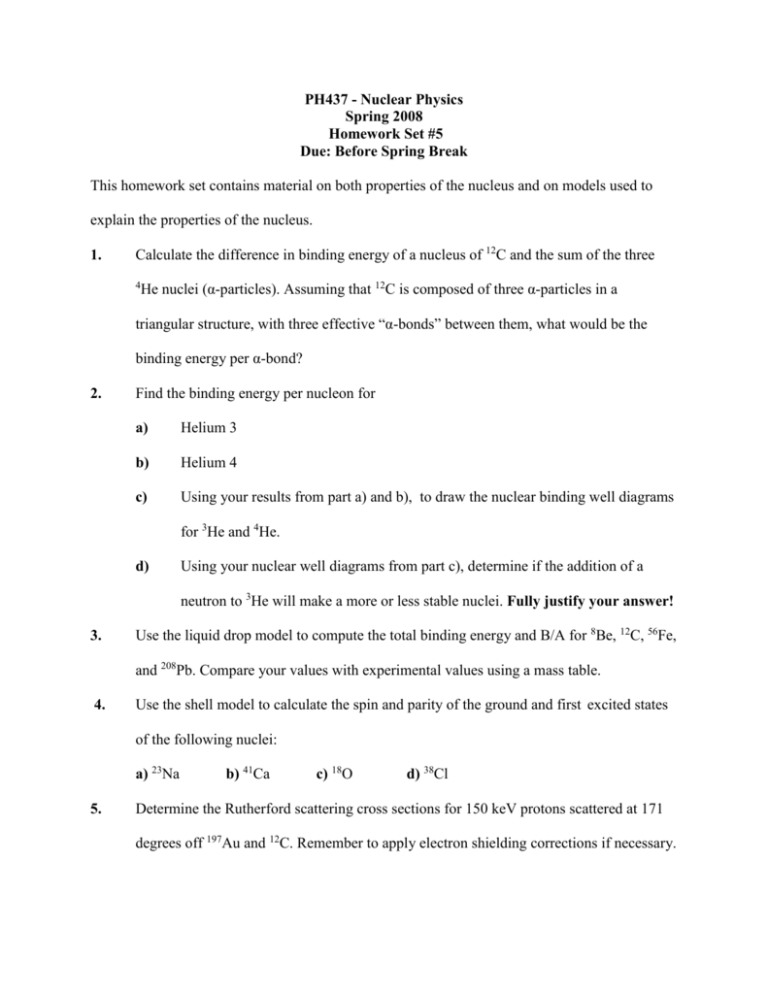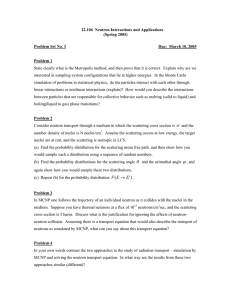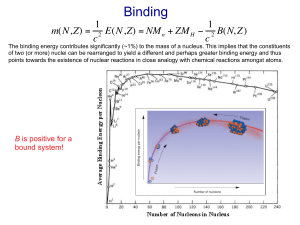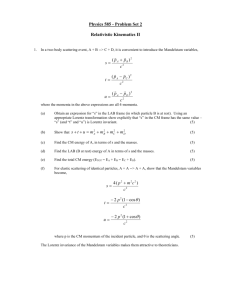1. Two particles are observed to emerge from a nuclear interaction
advertisement

PH437 - Nuclear Physics Spring 2008 Homework Set #5 Due: Before Spring Break This homework set contains material on both properties of the nucleus and on models used to explain the properties of the nucleus. 1. Calculate the difference in binding energy of a nucleus of 12C and the sum of the three 4 He nuclei (α-particles). Assuming that 12C is composed of three α-particles in a triangular structure, with three effective “α-bonds” between them, what would be the binding energy per α-bond? 2. Find the binding energy per nucleon for a) Helium 3 b) Helium 4 c) Using your results from part a) and b), to draw the nuclear binding well diagrams for 3He and 4He. d) Using your nuclear well diagrams from part c), determine if the addition of a neutron to 3He will make a more or less stable nuclei. Fully justify your answer! 3. Use the liquid drop model to compute the total binding energy and B/A for 8Be, 12C, 56Fe, and 208Pb. Compare your values with experimental values using a mass table. 4. Use the shell model to calculate the spin and parity of the ground and first excited states of the following nuclei: a) 23Na 5. b) 41Ca c) 18O d) 38Cl Determine the Rutherford scattering cross sections for 150 keV protons scattered at 171 degrees off 197Au and 12C. Remember to apply electron shielding corrections if necessary. 6. Assuming that the spin of a proton can be represented by a positive pion moving at a speed of c in a circular orbit of radius 1.00 fm about a neutral core as shown in the diagram below: + Neutral Core a) Calculate the pion current b) Calculate the magnetic moment due to the pion current c) How does your value in part b) compare with the experimentally determined magnetic moment for the proton of 2.79 μn. 7. In a nuclear fission reactor, MeV neutrons are thermalized through multiple elastic scattering events between the neutrons the nuclei that compose the moderator. Assuming that the moderator nuclei are approximately at rest: a) show that if a neutron with incident energy, Eo, undergoes elastic scattering with a moderator nuclei of nucleon number A, that the minimum energy scattering energy of the neutron, E1, is given by the formula: 2 A 1 E1 E A 1 o Hint: Minimum energy for neutron means that maximum energy has been transfered to the moderator nuclei so you can use your results from problem #1 of Homework set #4 to simplify your work. b) Using the formula from part a) determine how many collisions are required the kinetic energy of a neutron from 6 MeV to 1 eV if lead is used as the moderator Use the most common isotope of the moderator material to perform the calculation. c) Repeat part b) using a carbon moderator d) Based upon your results from part b) and c), would you want a high Z or low Z material to shield neutrons. 8. The following experimental data is similar to that obtained using the LC-400 Van de Graaff accelerator by CDT Bull during the spring of 1996 for protons scattered off a carbon foil as a function of proton beam energy. Beam Energy (keV) Counts Beam Energy (keV) Counts 255 237601 355 115096 265 213599 365 107074 275 198347 375 103147 285 184488 385 87232 295 168572 400 79313 305 162859 410 43635 315 152683 420 31718 325 142864 430 67415 335 128982 440 144886 345 122999 450 207407 Assuming that all data points were taken with the same experimental geometry and for the same number of incident protons, determine all energy regions where the scattering data indicates that the scattering between the proton and the carbon atom was Rutherford. (Hint: Plot the data on the appropriate type of graph and check for the Rutherford scattering energy dependence)








